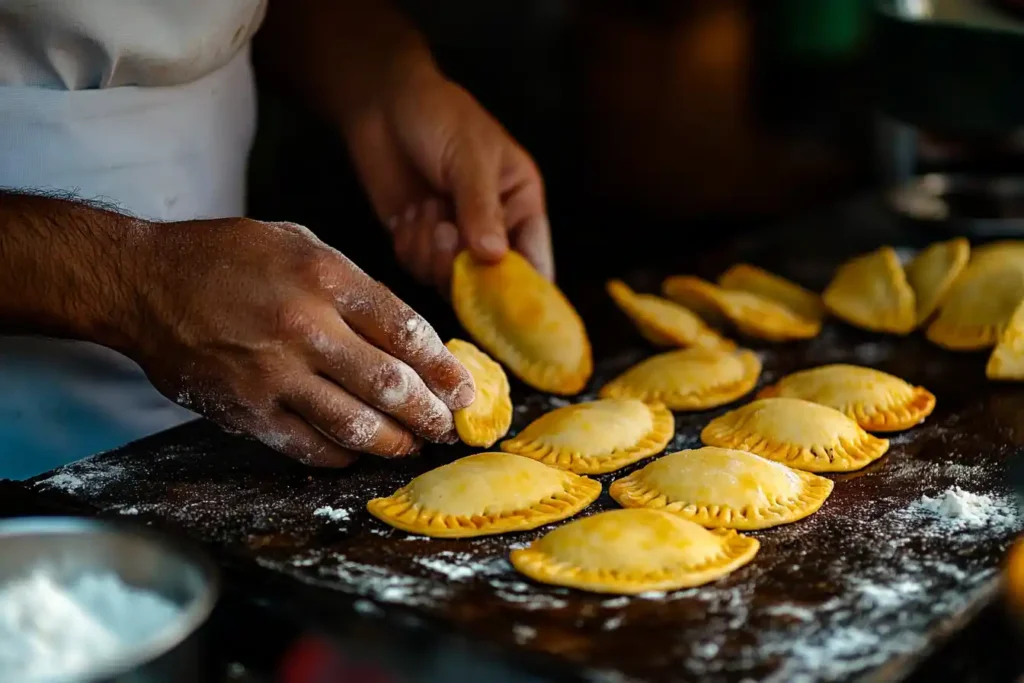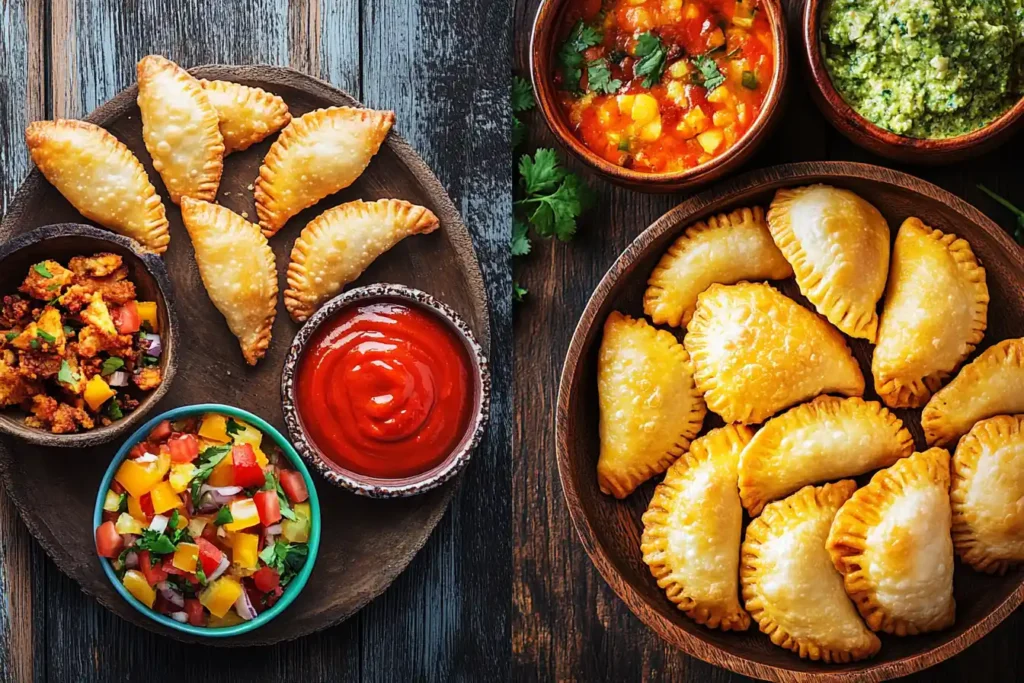Empanadas, those delightful pockets of dough filled with flavorful ingredients, are a cornerstone of Latin American cuisine. Yet, not all empanadas are created equal. Among the most famous are the Colombian and Venezuelan varieties, each showcasing the distinct culinary traditions of their respective countries. This article will take you on a journey through their history, ingredients, preparation techniques, and cultural significance. By the end, you’ll not only know the difference between Colombian and Venezuelan empanadas but also gain a deeper appreciation for the artistry behind these beloved treats.
Introduction to Colombian and Venezuelan Empanadas
What Are Empanadas?
At their core, empanadas feature a savory pastry shell that holds a variety of ingredients such as meats, vegetables, or cheeses. Derived from the Spanish verb empanar, meaning “to wrap in bread,” these versatile treats have evolved in every corner of Latin America, adapting to local flavors and preferences.
Colombian and Venezuelan empanadas stand out for their use of cornmeal-based dough and unique fillings. Unlike the wheat flour pastries more common in European-style empanadas, these versions highlight the region’s deep-rooted connection to maize.
Historical Context of Empanadas in Latin America
Empanadas trace their origins back to Spain, arriving in Latin America during the colonial era. Over time, they became a staple in countries like Colombia and Venezuela, where indigenous ingredients like corn and cassava shaped their evolution. Today, empanadas are not only a snack but a representation of cultural pride and ingenuity.
The Role of Empanadas in Colombian and Venezuelan Culture
For Colombians and Venezuelans, empanadas are more than just food—they’re a symbol of tradition. Found everywhere from bustling street markets to family gatherings, these tasty morsels bridge generations. Whether served at breakfast, lunch, or dinner, they bring people together with their comforting flavors and endless variety.
Key Ingredients and Preparation Techniques

Overview of Ingredients Used in Colombian Empanadas
Colombian empanadas boast hearty fillings and a crispy golden crust. Yellow cornmeal forms the base of the dough, creating its distinct texture and flavor. The fillings often include seasoned ground beef, chicken, or pork mixed with potatoes, which adds a creamy contrast to the crispy shell. Spices like cumin and achiote bring depth to the flavor, while accompaniments like ají, a spicy sauce made with cilantro and lime, elevate the dish.
Common Ingredients in Venezuelan Empanadas
In contrast, Venezuelan empanadas lean on versatility and bold flavors. The dough is also crafted from cornmeal but is typically softer and pliable. Popular fillings include shredded beef, black beans, plantains, and white cheese, reflecting the country’s rich culinary diversity. Seafood empanadas, filled with fish or shrimp, are also a beloved choice in coastal regions. The frying process infuses the dough with a rich flavor, making it irresistibly tender and flavorful.
Preparation Methods: Frying vs. Baking in Each Country
Colombian and Venezuelan empanadas traditionally fry to achieve their signature golden crust. However, slight variations in frying techniques impact the final result. Colombian empanadas typically deep-fry to create a crunchy exterior, while Venezuelan empanadas often pan-fry, offering a softer texture with crispy edges. Occasionally, baking provides a healthier alternative.
The Role of Cornmeal and Flour in Dough Texture
Cornmeal is the star ingredient in both empanada varieties, but its preparation differs. Colombian dough uses finely ground precooked cornmeal, yielding a thicker, firmer texture. Venezuelan dough, on the other hand, incorporates a slightly softer cornmeal, resulting in a more pliable and delicate crust. These differences highlight the regional preferences and culinary techniques unique to each country.
Flavor Profiles and Regional Variations
The Unique Flavors of Colombian Empanadas
Colombian empanadas are a savory delight, characterized by their earthy and aromatic flavor profile. The combination of spiced meats, potatoes, and the crispy cornmeal shell creates a perfect harmony of textures and tastes. In some regions, people pair empanadas with zesty ají sauce, which adds a tangy and spicy kick that enhances the rich filling.
Venezuelan Empanadas: Sweet, Savory, and Beyond
Venezuelan empanadas embrace a broader spectrum of flavors. The fillings often blend sweet and savory ingredients, such as plantains with cheese or meat with black beans. In coastal areas, seafood-filled empanadas stand out for their freshness and vibrant seasoning. This variety showcases Venezuela’s culinary adaptability, with each region infusing its empanadas with local ingredients and traditions.
Regional Variations Within Colombia and Venezuela
Colombian empanadas vary by region, with some areas favoring fillings like chorizo or rice and beans. In Antioquia, for instance, you’ll find empanadas stuffed with hogao, a savory tomato-onion mix. Venezuela also boasts regional diversity, from Andean-style empanadas stuffed with goat cheese to coastal varieties brimming with crab or shrimp. These regional nuances make exploring empanadas in both countries a culinary adventure.
The interplay of ingredients and techniques between these two styles underscores the difference between Colombian and Venezuelan empanadas. Their distinct textures, flavors, and cultural roots offer a delightful contrast for food lovers.
Culinary Techniques: A Side-by-Side Comparison
How Colombian Empanadas Are Made: Traditional Techniques
Colombian empanadas rely on precision and tradition. The dough combines finely ground precooked cornmeal with water and salt, creating a smooth yet firm consistency. Cooks shape the dough into thin, circular discs, which serve as the perfect casing for fillings like spiced meat and potatoes. After assembly, cooks deep-fry the empanadas in hot oil to achieve a crunchy, golden crust. This method ensures an irresistible texture that contrasts with the savory fillings.
Another hallmark of Colombian empanadas is their pairing with condiments. A tangy ají sauce, made with cilantro, lime, and peppers, adds an extra layer of flavor.
How Venezuelan Empanadas Are Made: A Unique Approach
Venezuelan empanadas take a slightly different approach, focusing on versatility and texture. The dough, made from cornmeal, features a softer consistency, making it more malleable. Cooks shape it into discs, fill it with ingredients like cheese, plantains, or black beans, and fold it into a half-moon shape. Instead of deep-frying, they often pan-fry these empanadas in a shallow layer of oil, creating a softer, tender crust with crispy edges.
Unlike Colombian empanadas, Venezuelan versions don’t rely heavily on sauces. Instead, the fillings themselves—ranging from sweet plantains to savory seafood—are designed to shine.
The Importance of Frying Oil, Heat, and Timing
Both Colombian and Venezuelan empanadas demand careful attention to frying oil and heat. Colombian empanadas are fried at high heat for a short time to achieve maximum crispiness. In contrast, Venezuelan empanadas require a gentler fry to retain their soft, pliable texture. Timing is crucial, as over-frying can dry out the fillings or cause the dough to burn.
By comparing these techniques, it’s clear what is the difference between Colombian and Venezuelan empanadas: one prioritizes crunch, while the other celebrates softness.
Social and Cultural Significance
The Role of Empanadas in Festivals and Gatherings
Empanadas are far more than simple snacks; they hold a special place in the social and cultural fabric of both Colombia and Venezuela. In Colombia, these savory treats are a staple at local fairs, bustling street markets, and family gatherings, where their portability and satisfying flavor make them a top choice for celebrations. Whether enjoyed as a quick bite on the go or shared among loved ones at festive events, they embody the spirit of togetherness. In Venezuela, empanadas take on a different but equally cherished role, often served as a breakfast favorite. Paired with a steaming cup of coffee or drizzled with freshly made guasacaca sauce, they provide a comforting start to the day while showcasing the nation’s diverse culinary flavors. In both countries, empanadas are more than just food—they’re a symbol of community, tradition, and shared joy.
How Empanadas Reflect National Identity
Empanadas showcase the culinary identity of each country. The Colombian version reflects the nation’s agricultural roots, using ingredients like potatoes and beef that are staples in its cuisine. Venezuelan empanadas highlight the diversity of its coastal and Andean regions, with fillings that vary based on local ingredients.
These differences emphasize the cultural pride both nations have in their food. Exploring what is the difference between Colombian and Venezuelan empanadas reveals not only culinary distinctions but also the stories of the people who make them.
If you’re looking for more recipes inspired by Latin America, explore additional guides on Magnetic Recipes.
How to Choose Between Colombian and Venezuelan Empanadas
Understanding Flavor Preferences

When deciding between Colombian and Venezuelan empanadas, your flavor preferences are key. If you enjoy crispy textures and savory fillings, Colombian empanadas are the way to go. Their crunchy exterior pairs perfectly with hearty fillings like spiced beef and potatoes, creating a satisfying bite. On the other hand, Venezuelan empanadas offer a softer, tender crust and a wider range of flavors, from sweet plantains to savory black beans and cheese. These options cater to those who appreciate bold, diverse combinations.
Where to Find Authentic Colombian and Venezuelan Empanadas
Authenticity is vital when savoring these iconic dishes. In Colombia, street vendors and local markets are the best places to try freshly made empanadas paired with spicy ají. Venezuela’s empanadas can often be found at small family-run shops or coastal stands, where you can experience their traditional seafood-filled versions. Additionally, many Latin American restaurants worldwide now serve both styles, giving food lovers a chance to compare and contrast these delicacies.
A Guide for First-Time Tasters
For first-time tasters, it’s helpful to start with the classics. Try a Colombian empanada filled with ground beef and potatoes for a straightforward introduction to its bold flavors. For Venezuelan empanadas, opt for the cheese and plantain combination, which offers a unique mix of sweet and savory. Whichever you choose, the experience will provide insights into what is the difference between Colombian and Venezuelan empanadas and highlight the culinary artistry of both countries.
FAQs About Colombian and Venezuelan Empanadas
What’s the Difference Between Colombian and Venezuelan Empanadas?
The most noticeable difference lies in their texture and flavor profile. Colombian empanadas are crispy, with a golden cornmeal crust and savory fillings like potatoes and beef. Venezuelan empanadas, while also made with cornmeal, have a softer, more tender crust and a variety of fillings, including sweet and savory options like plantains or black beans.
What Makes Each Country’s Empanadas Unique?
Colombian empanadas stand out for their crunchy exterior and hearty fillings, reflecting the country’s agricultural traditions. Venezuelan empanadas, however, are more versatile, with innovative filling combinations inspired by coastal and Andean influences. These unique traits showcase the cultural and regional diversity of both nations.
What Country Makes the Best Empanadas?
This question often sparks lively debates! Both countries excel at making empanadas, but the “best” ultimately depends on individual taste. Whether you prefer the crunch of Colombian empanadas or the softer texture of Venezuelan ones, both offer unforgettable culinary experiences.
How Are Empanadas Different From Arepas?
While both empanadas and arepas are made from cornmeal, their preparation and purpose differ. Empanadas are stuffed and fried pastries, enjoyed as snacks or meals. Arepas, on the other hand, are flatbreads that can be grilled, fried, or baked and served as a side dish or sandwich. Each is a testament to the rich culinary heritage of Colombia and Venezuela.
If you’d like to try making empanadas at home, explore this empanada recipe guide for helpful tips and inspiration.
Conclusion
Summarizing the Key Differences
By now, it’s clear what is the difference between Colombian and Venezuelan empanadas. Colombian empanadas are known for their crispy, golden crusts and hearty, savory fillings like potatoes and spiced meat. Meanwhile, Venezuelan empanadas shine with their soft, tender dough and bold, diverse fillings that often combine sweet and savory ingredients, like plantains and cheese. These distinctions go beyond just taste and texture—they reflect the unique culinary traditions and regional influences of each country.
Celebrating Diversity in Culinary Traditions
Empanadas are more than just food; they’re a celebration of culture and community. Both Colombian and Venezuelan empanadas offer a delicious window into the history and identity of their respective countries. Whether you prefer the crunch of a Colombian empanada or the softness of a Venezuelan one, these iconic dishes highlight the beauty of diversity in Latin American cuisine.


2 thoughts on “Colombian vs. Venezuelan Empanadas: Key Differences Explained”